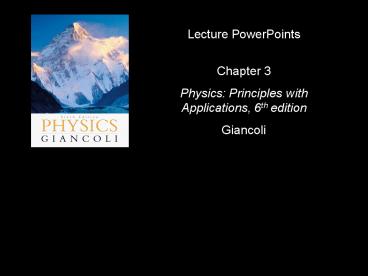Lecture PowerPoints - PowerPoint PPT Presentation
1 / 26
Title:
Lecture PowerPoints
Description:
Lecture PowerPoints Chapter 3 Physics: Principles with Applications, 6th edition Giancoli Chapter 3 Kinematics in Two Dimensions; Vectors Units of Chapter 3 Vectors ... – PowerPoint PPT presentation
Number of Views:208
Avg rating:3.0/5.0
Title: Lecture PowerPoints
1
Lecture PowerPoints Chapter 3 Physics
Principles with Applications, 6th edition Giancoli
2
Chapter 3 Kinematics in Two Dimensions Vectors
3
Units of Chapter 3
- Vectors and Scalars
- Addition of Vectors Graphical Methods
- Subtraction of Vectors, and Multiplication of a
Vector by a Scalar - Adding Vectors by Components
- Projectile Motion
- Solving Problems Involving Projectile Motion
- Projectile Motion Is Parabolic
- Relative Velocity
4
3-1 Vectors and Scalars
A vector has magnitude as well as direction. Some
vector quantities displacement, velocity, force,
momentum A scalar has only a magnitude. Some
scalar quantities mass, time, temperature
5
3-2 Addition of Vectors Graphical Methods
For vectors in one dimension, simple addition and
subtraction are all that is needed. You do need
to be careful about the signs, as the figure
indicates.
6
3-2 Addition of Vectors Graphical Methods
If the motion is in two dimensions, the situation
is somewhat more complicated. Here, the actual
travel paths are at right angles to one another
we can find the displacement by using the
Pythagorean Theorem.
7
3-2 Addition of Vectors Graphical Methods
Adding the vectors in the opposite order gives
the same result
8
3-2 Addition of Vectors Graphical Methods
Even if the vectors are not at right angles, they
can be added graphically by using the
tail-to-tip method.
9
3-2 Addition of Vectors Graphical Methods
The parallelogram method may also be used here
again the vectors must be tail-to-tip.
10
3-3 Subtraction of Vectors, and Multiplication of
a Vector by a Scalar
In order to subtract vectors, we define the
negative of a vector, which has the same
magnitude but points in the opposite direction.
Then we add the negative vector
11
3-3 Subtraction of Vectors, and Multiplication of
a Vector by a Scalar
A vector V can be multiplied by a scalar c the
result is a vector cV that has the same direction
but a magnitude cV. If c is negative, the
resultant vector points in the opposite direction.
12
3-4 Adding Vectors by Components
Any vector can be expressed as the sum of two
other vectors, which are called its components.
Usually the other vectors are chosen so that they
are perpendicular to each other.
13
3-4 Adding Vectors by Components
If the components are perpendicular, they can be
found using trigonometric functions.
14
3-4 Adding Vectors by Components
The components are effectively one-dimensional,
so they can be added arithmetically
15
3-4 Adding Vectors by Components
- Adding vectors
- Draw a diagram add the vectors graphically.
- Choose x and y axes.
- Resolve each vector into x and y components.
- Calculate each component using sines and
cosines. - Add the components in each direction.
- To find the length and direction of the vector,
use
16
3-5 Projectile Motion
A projectile is an object moving in two
dimensions under the influence of Earth's
gravity its path is a parabola.
17
3-5 Projectile Motion
It can be understood by analyzing the horizontal
and vertical motions separately.
18
3-5 Projectile Motion
The speed in the x-direction is constant in the
y-direction the object moves with constant
acceleration g. This photograph shows two balls
that start to fall at the same time. The one on
the right has an initial speed in the
x-direction. It can be seen that vertical
positions of the two balls are identical at
identical times, while the horizontal position of
the yellow ball increases linearly.
19
3-5 Projectile Motion
If an object is launched at an initial angle of
?0 with the horizontal, the analysis is similar
except that the initial velocity has a vertical
component.
20
3-6 Solving Problems Involving Projectile Motion
Projectile motion is motion with constant
acceleration in two dimensions, where the
acceleration is g and is down.
21
3-6 Solving Problems Involving Projectile Motion
- Read the problem carefully, and choose the
object(s) you are going to analyze. - Draw a diagram.
- Choose an origin and a coordinate system.
- Decide on the time interval this is the same in
both directions, and includes only the time the
object is moving with constant acceleration g. - Examine the x and y motions separately.
22
3-6 Solving Problems Involving Projectile Motion
6. List known and unknown quantities. Remember
that vx never changes, and that vy 0 at the
highest point. 7. Plan how you will proceed. Use
the appropriate equations you may have to
combine some of them.
23
3-7 Projectile Motion Is Parabolic
In order to demonstrate that projectile motion is
parabolic, we need to write y as a function of x.
When we do, we find that it has the form
This is indeed the equation for a parabola.
24
3-8 Relative Velocity
We already considered relative speed in one
dimension it is similar in two dimensions except
that we must add and subtract velocities as
vectors.
Each velocity is labeled first with the object,
and second with the reference frame in which it
has this velocity. Therefore, vWS is the velocity
of the water in the shore frame, vBS is the
velocity of the boat in the shore frame, and vBW
is the velocity of the boat in the water frame.
25
3-8 Relative Velocity
In this case, the relationship between the three
velocities is
(3-6)
26
Summary of Chapter 3
- A quantity with magnitude and direction is a
vector. - A quantity with magnitude but no direction is a
scalar. - Vector addition can be done either graphically
or using components. - The sum is called the resultant vector.
- Projectile motion is the motion of an object
near the Earths surface under the influence of
gravity.































